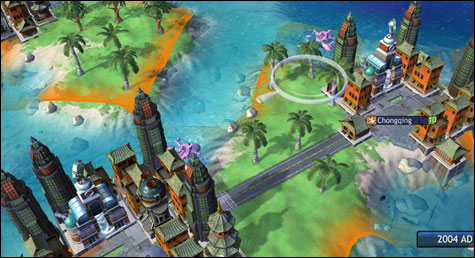
POWER PLAYS: You can turn Paris into an Aztec city and settle Fyodor Dostoevsky in Tenochtitlan. |
| Sid Meier’s Civilization: Revolution | For the Xbox 360, PlayStation 3, and Nintendo DS | Rated E10+ for ages 10 and older | Developed by Firaxis | Published by 2K Games |
For some, strategy games can seem intimidating. Monitoring production, expanding your territory, building up an army, and practicing diplomacy with other groups can all start to feel overwhelming, particularly if the most “strategy” you’re used to in a video game is “Should I use the shotgun or the semi-automatic?” The latest installment in designer Sid Meier’s venerable Civilization series, which may be the best-known in the genre, is for those gamers — the ones who were busy playing Quake and Super Metroid while others were playing, well, Civilization.You start by picking a people to steward through the world; most major groups are represented in the game and come with their own historic leader, like Catherine the Great or Abraham Lincoln. Other than cosmetic differences such as the names of the cities you found and certain capacities you start out with (the Greeks get democracy, Indians get religion) or acquire throughout the years, there’s not much difference among the groups. This is a change from previous installments, which assigned particular attributes to this and that civilization — some were more inclined toward military science, others toward natural science. What’s also different is that there aren’t as many individual classes of civilians, like tax collectors or “humanitarians.” The only people (or “units,” in the game’s parlance) you can create are soldiers, spies, and territory-expanding settlers.
You’ll periodically earn “Great People,” historic figures who can settle in one of your cities to help with your efforts. The upshot of all this building and scheming is that you can turn Paris into an Aztec city and settle Fyodor Dostoevsky in Tenochtitlan. It can be amusing. Less entertaining is sending an army of tanks and bomber jets to besiege a city only to be foiled by soldiers armed with pikes and rifles — combat is hands-off and entirely dependent on the stats of your armies. You’re just giving them their marching orders.
The difficulty has been scaled back: there aren’t more than five AI opponents at a time, and it’s not hard to avoid at least one of them during the course of a full game. Although play is still turn-based — meaning each unit can do only one thing at a time — you’ll still find you have ample time to build, say, a barracks and a university in the same city. You can play an entire campaign in a single sitting. The AI is predictable, and your production and your military are frequently upgraded. The slightly cartoonish presentation also adds to the sense of inclusiveness.
The streamlined scope might not appeal to veterans of the PC version of the series, however — in the end, there are still only so many ways to play. In theory, the different scenario handicaps and multi-player modes give experienced players more options, but not everyone will deem these sufficient compensation. Then again, this game isn’t really for people who would rather play the game on a PC or a Mac. It’s for the rest of us. Civilization Revolution demystifies the genre for the newcomers. If even a few gamers run out and install Civilization IV afterward, Revolution will have done its job.